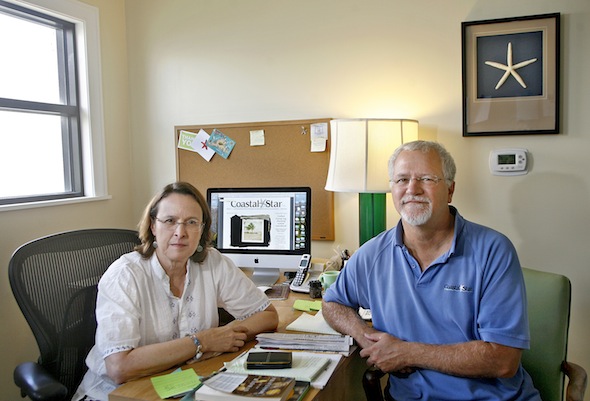
When Mary Kate Leming found herself among the 300 Palm Beach Post employees who lost their jobs in a sweeping downsizing in 2008, she enacted an unlikely Plan B, taking out a home equity credit line to start a print newspaper. After 22 years at the Post, she didn’t want to leave journalism yet, and she and her husband, also a newspaper exile, saw a need in their own community for professional news coverage.
She never thought the plan would work as well as it has.
Leming and her husband, Jerry Lower, a photographer who was laid off from the South Florida Sun Sentinel, started The Coastal Star, a monthly paper that covers nine beachfront towns in southern Palm Beach County. The couple expected the endeavor to maybe last five years, a fun jaunt in which they hopefully wouldn’t lose too much money.
They’ve exceeded that initial goal. Last month the Coastal Star, which, in addition to Lower and Leming, has a full-time ad manager, moved into a larger office space, right around the time the paper won 13 awards from the Florida Press Association, including seven first places. Last year the paper, which has a circulation of 18,000, spent $343,000 on local freelancers, many of them reporters, photographers, salespeople, and designers who were similarly exiled from area dailies, Lower said. And the couple has paid back the $150,000 home loan that covered their startup costs. Leming and Lower found a niche that actually could support a new print newspaper.
“A lot of our readers are older, which contributes to our success,” Leming told me. “The paper is genuinely beloved. People just gush; it’s almost embarrassing. People felt that no one was covering their town, and they missed the stories about their neighbors.”
The fact that those neighbors are wealthy enough to live on the barrier island in Palm Beach County has also been important; the paper, distributed for free and fully ad-supported, is full of real estate ads. The coverage area includes tony Manalapan, where Bloomberg notes that the average per capita income is $199,143, the third highest of any community in the country. The median age is 61, according to the US Census. Another community in The Coastal Star‘s coverage area, Gulfstream, FL, made the top 25 list, with an average per capita income of $132,000 and an average age of 58. These are people advertisers want to reach. And they still read newspapers.
That fact has made it possible for The Coastal Star to break news and fix things, the old-school journalism way. Leming is particularly proud of a two-part piece on lessons learned from Hurricane Sandy, which swiped the coast and caused serious beach erosion and seawall destruction. The series dug into the politics and red tape of beach protection and the costs of rebuilding.
The little paper that could also covered the choking death of a 40-year-old man who lived in what’s called the county pocket, a beachfront area that isn’t part of any municipality. Leming said the man’s obituary really touched readers, but the story and editorial the Star did on the fact that a county rescue truck took 13 minutes to reach him, passing city fire stations on the way, changed things for island residents. The county and one of the local cities set up specific criteria for when a city rescue unit would be dispatched in a life-threatening emergency in the county pocket.
“We actually improved the mutual aid agreement between the county and Boynton Beach,” Lower said.
These stories and others, big and small, are largely covered by seasoned print journalists, old friends of Leming and Lower, who pay them on time to do traditional, boots-on-the-ground reporting. The Coastal Star, for example, is at every city commission meeting in the town of Manalapan, population 427.
What has not worked for The Coastal Star is digital, which surprised Leming, who spent six years at The Palm Beach Post on the digital side. She expected the Coastal Star‘s website to become quickly popular, she told me, and maybe even eclipse the print edition. And she set it up to be a micro-social media site, expecting neighbors to connect with each other there. That hasn’t worked. Their site doesn’t get much traction, and Leming and Lower have not bothered to sell ads on it for that reason.
So six years out, the couple find themselves running an old-fashioned publication that, contrary to their own expectations, is far from failing.
“We saw the decline in the dailies and thought this would ultimately go the same way,” Lower said. “We were surprised with how popular it’s become.”
Susannah Nesmith is CJR’s correspondent for Florida, Georgia, and Alabama. She is a freelance writer based in Miami with more than 25 years working for regional and national outlets. Follow her on Twitter @susannahnesmith.
